Learning development and performance managementPPT课件
英语作文-高等教育行业中的教学质量与学习成果评价

英语作文-高等教育行业中的教学质量与学习成果评价In the realm of higher education, the evaluation of teaching quality and learning outcomes is a critical aspect that institutions continuously strive to improve. This evaluation is not only a measure of the effectiveness of educational delivery but also a reflection of the institution's commitment to fostering an environment conducive to learning and personal development.Teaching Quality。
Teaching quality in higher education can be assessed through various metrics, such as student engagement, instructional methods, curriculum relevance, and faculty expertise. Effective teaching is characterized by the ability to convey complex concepts in a manner that is accessible and engaging to students. It involves creating a dynamic learning environment where students are encouraged to think critically and apply their knowledge in practical settings.One approach to evaluating teaching quality is through student feedback. Surveys and questionnaires can provide valuable insights into students' perceptions of their learning experience. However, it is essential to consider the subjective nature of such feedback and to complement it with more objective measures, such as peer reviews of teaching practices and analysis of student performance data.Learning Outcomes。
五年级上册英语四单元readandwrite
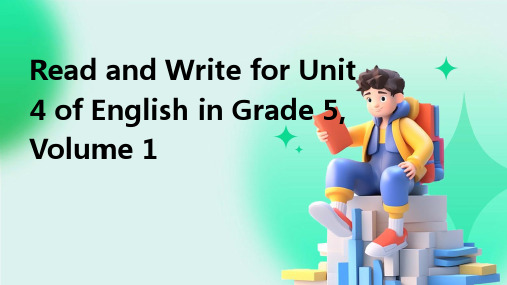
Language focus: This unit focuses on specific grammar points such as verb tenses, adjectives, and adverbs. It also introduces new vocabulary related to the themes of the readings, providing opportunities for students to expand their lexical repertoire.
Sentence Structures
Simple present tense is used to describe daily habits and routines. Example sentences include "I wake up at 7 o'clock every morning," and "After I eat breakfast, I go to school."
Have students skim the text to get a general idea of the main points and identify the theme.
Teach students to scan the text for specific information, such as key vocabulary words and phrases related to daily routines.
introducing more complex language structures and a wider range of vocabulary to enhance students' language proficiency.
performance management
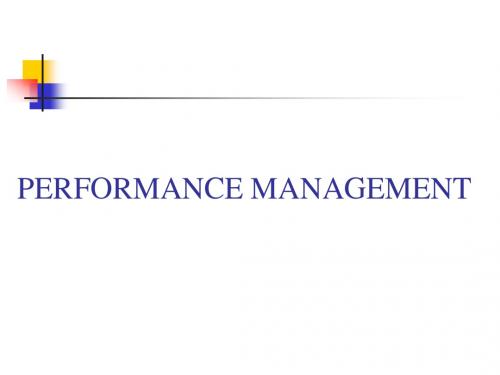
Carrying out
Planning
Types of Learning and Development
◆Off-job methods (e.g. MBA) ◆Learning in the job (e.g. Coaching) ◆E-learning
Evaluating Performance Management
Source from:Michael Armstrong (1994) Performance Management. Kogan Page.London.p181
Performance Management as a process
According to the framework, it's to know which performance management is a top-down affair: Less focus on retrospective performance assessment and more concentration on future performance planning and improvement Identification and recognition of outputs which are defined in qualitative terms and not just quantitative ones A freer, upwardly managed process A more coaching and counseling style of appraisal with less emphasis on criticism
Source from: Armstrong Michael (1994) Performance Management. Kogan Page Limited London, pp.23
RaymondMHP版雇员培训与开发(英文版第6版)ppt课件
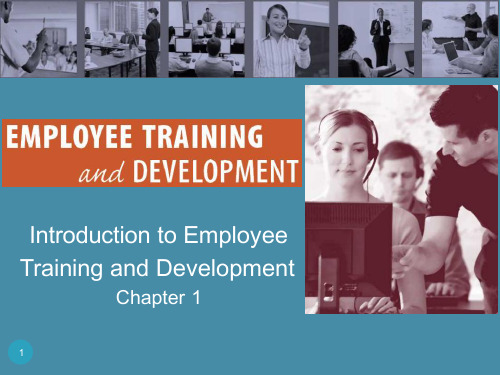
Introduction Competitiveness: Ability to maintain and gainmarket share in an industry Human resource management: Policies, practices, and systems that influence employees’ behaviour, attitudes, and performance Stakeholders: All parties that have an interest in seeing that the company succeeds
91-9
and
Designing Effective Training Training design process Systematic approach for developing training programs Based on the principles of Instructional System Design (ISD) ADDIE model- Analysis, design, development, implementation, and evaluation Should be systematic yet flexible to adapt to business needs
Training and Development: KeyComponents of Learning Learning: Acquiring knowledge, skills,competencies, attitudes, or behaviors Human capital: Refers to: Knowledge (know what) Advanced skills (know how) System understanding and creativity (know why) Motivation to deliver high-quality products and services (care why)
3-6岁儿童学习与发展指南和关键经验
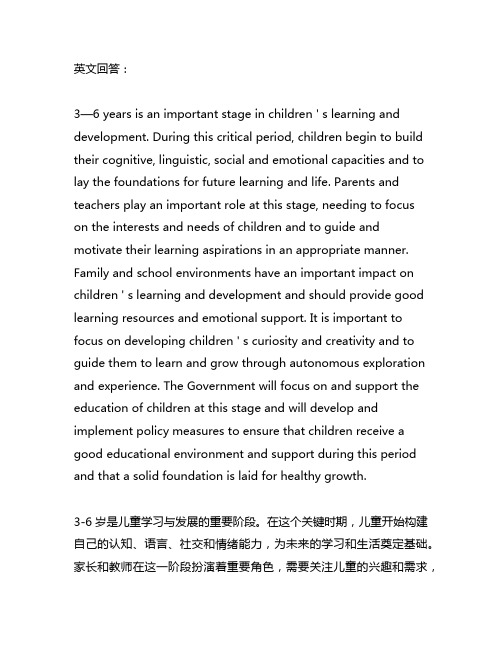
英文回答:3—6 years is an important stage in children ' s learning and development. During this critical period, children begin to build their cognitive, linguistic, social and emotional capacities and to lay the foundations for future learning and life. Parents and teachers play an important role at this stage, needing to focuson the interests and needs of children and to guide and motivate their learning aspirations in an appropriate manner. Family and school environments have an important impact on children ' s learning and development and should provide good learning resources and emotional support. It is important to focus on developing children ' s curiosity and creativity and to guide them to learn and grow through autonomous exploration and experience. The Government will focus on and support the education of children at this stage and will develop and implement policy measures to ensure that children receive a good educational environment and support during this period and that a solid foundation is laid for healthy growth.3-6岁是儿童学习与发展的重要阶段。
英语月教学反思万能模板
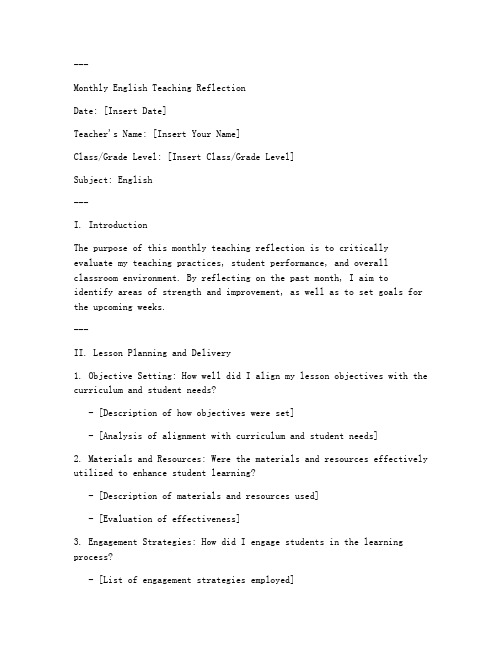
---Monthly English Teaching ReflectionDate: [Insert Date]Teacher's Name: [Insert Your Name]Class/Grade Level: [Insert Class/Grade Level]Subject: English---I. IntroductionThe purpose of this monthly teaching reflection is to critically evaluate my teaching practices, student performance, and overall classroom environment. By reflecting on the past month, I aim toidentify areas of strength and improvement, as well as to set goals for the upcoming weeks.---II. Lesson Planning and Delivery1. Objective Setting: How well did I align my lesson objectives with the curriculum and student needs?- [Description of how objectives were set]- [Analysis of alignment with curriculum and student needs]2. Materials and Resources: Were the materials and resources effectively utilized to enhance student learning?- [Description of materials and resources used]- [Evaluation of effectiveness]3. Engagement Strategies: How did I engage students in the learning process?- [List of engagement strategies employed]- [Analysis of student response and engagement]4. Assessment Techniques: How did I assess student understanding and progress?- [Description of assessment techniques used]- [Evaluation of the effectiveness of assessments]---III. Student Performance and Behavior1. Academic Progress: What were the strengths and weaknesses observed in student performance?- [Analysis of student strengths and weaknesses]- [Identification of specific areas for improvement]2. Classroom Behavior: How was the overall behavior of the class during the month?- [Description of classroom behavior]- [Analysis of any behavioral issues and strategies used to address them]3. Student Engagement: How did students engage with the content and activities?- [Evaluation of student engagement levels]- [Identification of factors influencing engagement]---IV. Professional Development1. Continuous Learning: What professional development activities did I engage in?- [List of professional development activities]- [Reflection on the impact of these activities]2. Collaboration: How did I collaborate with colleagues or other educators?- [Description of collaborative efforts]- [Evaluation of the effectiveness of collaboration]---V. Challenges and Solutions1. Challenges: What challenges did I encounter during the month?- [List of challenges faced]- [Analysis of the impact of these challenges]2. Solutions: What strategies did I implement to overcome these challenges?- [Description of strategies used]- [Evaluation of the effectiveness of these solutions]---VI. Goals and Actions for the Upcoming Month1. Objective Setting: What are my objectives for the upcoming month?- [List of objectives]2. Action Plan: What specific actions will I take to achieve these objectives?- [Detailed action plan]3. Reflection Schedule: When will I next reflect on my teaching?- [Schedule for future reflections]---VII. ConclusionReflecting on my teaching practices has provided me with valuable insights into my strengths and areas for growth. By identifying and addressing these areas, I am confident that I will be able to enhance the learning experience for my students. As I move forward, I will remain committed to continuous improvement and the pursuit of excellence in my teaching.---End of Reflection[Teacher's Signature][Date]---Note: This template can be adapted to fit the specific needs and requirements of the individual teacher and their teaching context.。
人才培养计划英语
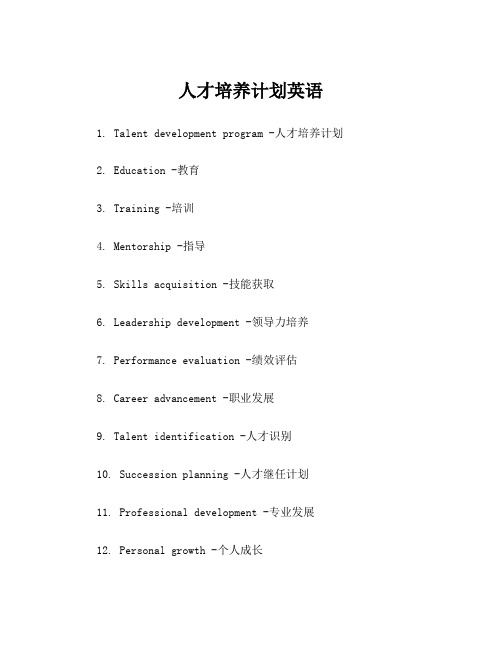
人才培养计划英语1. Talent development program -人才培养计划2. Education -教育3. Training -培训4. Mentorship -指导5. Skills acquisition -技能获取6. Leadership development -领导力培养7. Performance evaluation -绩效评估8. Career advancement -职业发展9. Talent identification -人才识别10. Succession planning -人才继任计划11. Professional development -专业发展12. Personal growth -个人成长13. Recruitment -招聘14. Retention -留任15. Onboarding -入职16. Job rotation -岗位轮岗17. Cross-training -跨部门培训18. Performance management -绩效管理19. Continuous learning -持续学习20. Talent pipeline -人才储备21. Talent retention strategies -人才留存策略22. Talent development budget -人才发展预算23. Talent management software -人才管理软件24. Talent development goals -人才发展目标25. Employee engagement -员工参与度26. Workforce planning -劳动力规划27. Reward and recognition -奖励与认可28. Performance improvement -绩效提升29. Employee development plan -员工发展计划1. Our company has implemented a talent development program to nurture the skills and potential of our employees.我们公司已经实施了一个人才培养计划,培养员工的技能和潜力。
培训计划英文缩写大全

培训计划英文缩写大全1. HR - Human Resources2. L&D - Learning and Development3. TNA - Training Needs Analysis4. KPI - Key Performance Indicators5. ROI - Return on Investment6. OJT - On-the-Job Training7. T&D - Training and Development8. SME - Subject Matter Expert9. LMS - Learning Management System10. CBT - Computer-Based Training11. TTT - Train-the-Trainer12. ILT - Instructor-Led Training13. E-Learning - Electronic Learning14. CPD - Continuous Professional Development15. LXP - Learning Experience Platform16. PD - Professional Development17. LSP - Learning Service Provider18. TTT - Time to Train19. VT - Virtual Training20. M-learning - Mobile Learning21. VET - Vocational Education and Training22. TPI - Training Performance Indicator23. PBL - Problem-Based Learning24. CMT - Competency Mapping and Training25. TME - Training Management and Evaluation26. PDP - Personal Development Plan27. PEBL - Performance-Based Evaluation and Learning28. TCO - Total Cost of Ownership29. SMS - Safety Management System30. TMS - Training Management System31. HSE - Health, Safety, and Environment32. PFPD - Professional and Personal Development33. SRC - Skills Recognition and Certification34. SMS - Safety Management System35. STP - Succession Training Program36. WBL - Work-Based Learning37. WIL - Work-Integrated Learning38. SML - Simulation-Based Learning39. TB - Training Budget40. TCB - Training and Competency Building41. END - Education and Development Network42. CDP - Continuing Development Program43. ODL - Open and Distance Learning44. VPL - Vocational Pathway Learning45. EPSP - Education and Professional Skills Program46. STP - Staff Training Program47. ITT - Instructor Training Program48. EDT - Employee Development and Training49. PDD - Professional Development and Training50. ETP - Educator Training Program51. PRP - Personalized Learning Plan52. TMS - Talent Management System53. HTP - High-Tech Training Program54. LTMP - Learning and Talent Management Program55. WTKP - Workforce Training and Knowledge Program56. ETP - Education and Training Program57. PDDP - Product Development and Design Program58. KPDP - Knowledge and Practice Development Program59. TLP - Talent Learning Program60. HLP - Human Learning Program。
学习环境英文摘抄作文
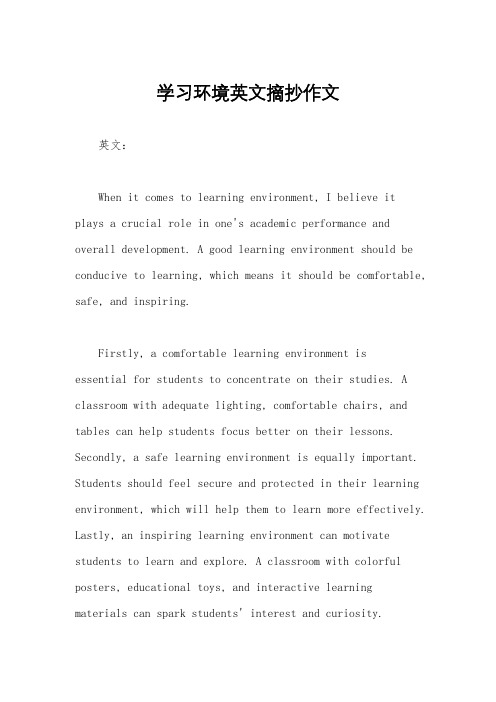
学习环境英文摘抄作文英文:When it comes to learning environment, I believe it plays a crucial role in one's academic performance and overall development. A good learning environment should be conducive to learning, which means it should be comfortable, safe, and inspiring.Firstly, a comfortable learning environment isessential for students to concentrate on their studies. A classroom with adequate lighting, comfortable chairs, and tables can help students focus better on their lessons. Secondly, a safe learning environment is equally important. Students should feel secure and protected in their learning environment, which will help them to learn more effectively. Lastly, an inspiring learning environment can motivate students to learn and explore. A classroom with colorful posters, educational toys, and interactive learningmaterials can spark students' interest and curiosity.In addition, a good learning environment should also have supportive teachers and peers. Teachers who are approachable, caring, and knowledgeable can create a positive learning atmosphere that encourages students to ask questions and seek help. Peers who are friendly and supportive can also make the learning experience more enjoyable and engaging.Overall, a good learning environment should be comfortable, safe, inspiring, and supportive. It should be a place where students can learn, grow, and thrive.中文:谈到学习环境,我认为它对一个人的学业表现和整体发展起着至关重要的作用。
培训开发理论模型及讲解(培训管理者必懂的知识理论模型)
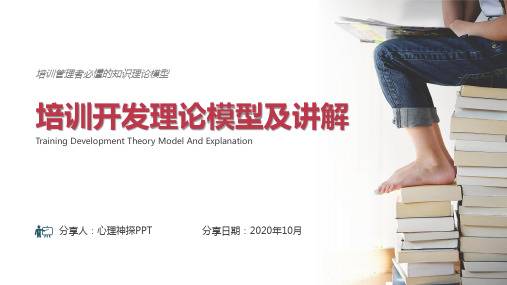
兴趣 学员
问卷调查 小组访谈 工作跟踪
困难
培训需求差距分析模型
所需的培训水平
理想 的技 能水 平
现有 的技 能水 平
实操流程
理想状态
理想状态的技 能水平要求? ASK分别是什 么?
现实状态
现实表现出来 的技能水平? ASK分别怎么 样?
定准差距
定位差距点; 准确识别哪些是 可以通过培训解 决的差距? ASK分别培训什 么?
培训需求评价系性模型。
应用 Goldstein 模型目前是全球范围内认同度最 广的培训需求分析模型。对专业性要求较高, 且未考虑员工想学什么。
培训需求调查体系
参加公司会议 与高层经理直接面谈 研究会议纪要和业务重点
战略
文化 公司
目标
直接面谈 问卷调查 绩效考评
业绩
工作 主管
需求查 问题 发展
来源 莎朗·L·波曼(Sharon L.
Bowman) 职 业 演 说 家 、 公司培训师学区以及大学 员工发展顾问与导师著有8 部培训与激励学习方面的 著作。
应用 用于课堂教学策略, 活
动的设计,书中提及4个环 节共计65种策略。
库伯学习圈-体验式设计
来源 大 卫 · 库 伯 (David kolb) 在 总 结 了 约 翰 · 杜 威
来源
美国学者汤姆·W·戈特将“现实状态”与“理想状态”
之间的“差距”称为缺口,并依此确定员工知识、技能
和态度等培训内容,这就是培训需求差距分析模型。
应用
企业培训需求分析常用的模。笔者
认为更适合于解决短期的,单点的培训
的问题。
前瞻性培训需求分析模型
满意的 工作绩效
来源 由美国学者Terry·L·leap和Michael D·Crino 提出的。将“前瞻性”思想运用在培训需求分 析是该模型的精髓。他们认为随着技术的不断 进步和员工的个人成长需要,即使员工目前的 工作绩效是令人满意的,也可能会因为需要为 工作调动做准备、为职位晋升做准备等原因提 出培训的要求。前瞻性培训需求分析模型为这 些情况提供了良好的分析框架,如右图:
LEARNING STYLES

LEARNING STYLESStudents preferentially take in and process information in different ways: by seeing and hearing, reflecting and acting, reasoning logically and intuitively, analyzing and visualizing, steadily and in fits and starts. Teaching methods also vary. Some instructors lecture, others demonstrate or lead students to self-discovery; some focus on principles and others on applications; some emphasize memory and others understanding.When mismatches exist between learning styles of most students in a class and the teaching style of the professor, the students may become bored and inattentive in class, do poorly on tests, get discouraged about the courses, the curriculum, and themselves, and in some cases change to other curricula or drop out of school. Professors, confronted by low test grades, unresponsive or hostile classes, poor attendance and dropouts, know something is not working. They may become overly critical of their students (making things even worse) or begin to wonder if they are in the right profession. Most seriously, society loses potentially excellent professionals. To overcome these problems, professors should strive for a balance of instructional methods (as opposed to trying to teach each student exclusively according to his or her preferences.) If the balance is achieved, all students will be taught partly in a manner they prefer, which leads to an increased comfort level and willingness to learn, and partly in a less preferred manner, which provides practice and feedback in ways of thinking and solving problems which they may not initially be comfortable with but which they will have to use to be fully effective professionals.This site contains resources for a model of learning styles generally referred to as the Felder-Silverman model. The model was originally formulated by Dr. Felder in collaboration with Dr. Linda K. Silverman, an educational psychologist, for use by college instructors and students in engineering and the sciences, although it has subsequently been applied in a broad range of disciplines.Video of an interview with Richard FelderIntroduction to Learning Styles, a taped interview at California State University at Dominguez Hills.Assessment of learning style preferencesThe Index of Learning Styles is a self-scoring questionnaire for assessing preferences on four dimensions of the Felder-Silverman model.Descriptions of learning styles. A four-page handout that brieflyexplains the learning style preferences obtained using the Index of Learning Styles.Publications related to the Felder-Silverman Learning Style Model1.R.M. Felder and L.K. Silverman, "Learning and Teaching Styles inEngineering Education,"Engr. Education, 78(7), 674-681 (1988).The article that originally defined the Felder-Silverman model and identified teaching practices that should meet the needs ofstudents with the full spectrum of styles. The paper is preceded by a 2002 preface that states and explains changes in the model that have been made since 1988.2.R.M. Felder, "Reaching the Second Tier: Learning and TeachingStyles in College Science Education,"J. College Science Teaching, 23(5), 286-290 (1993). An updated presentation of theFelder-Silverman model.3.R.M. Felder and E.R. Henriques, "Learning and Teaching Styles inForeign and Second Language Education,"Foreign Language Annals, 28(1), 21-31 (1995). Application of the F-S learning style model to language education.4.R.M. Felder and J.E. Spurlin, "Applications, Reliability, andValidity of the Index of Learning Styles."Intl. Journal ofEngineering Education, 21(1), 103-112 (2005). A validation study of the Index of Learning Styles.5.T.A. Litzinger, S.H. Lee, J.C. Wise, and R.M. Felder, "APsychometric Study of the Index of Learning Styles."J. Engr.Education, 96(4), 309-319 (2007). Reliability, factor structure, and construct validity of the Index of Learning Styles.Publications related to learning styles in general and other learning style models1.R.M. Felder and R. Brent, "Understanding Student Differences."J.Engr. Education, 94(1), 57-72 (2005). An exploration of differences in student learning styles, approaches to learning (deep, surface, and strategic), and levels of intellectual development, with recommended teaching practices to address all three categories.2.R.M. Felder, "Matters of Style."ASEE Prism, 6(4), 18-23 (December1996). Principles and applications of four learning style models (Felder-Silverman, Kolb, and models based on the Myers-Briggs Type Indicator and the Herrmann Brain Dominance Instrument). The paper concludes that the choice of a model is almost irrelevant: teaching designed to address all dimensions on any of the models is likely to be effective, and all of the models lead to more or less the same instructional approach.3.R.M. Felder, "Are Learning Styles Invalid? (Hint: No!)."On-CourseNewsletter, September 27, 2010. A response to claims that no evidence justifies taking learning styles into account whendesigning instruction.4.R.M. Felder, G.N. Felder, and E.J. Dietz, "The Effects ofPersonality Type on Engineering Student Performance andAttitudes."J. Engr. Education, 91(1), 3-17 (2002). TheMyers-Briggs Type Indicator was administered to 116 sophomore engineering students, whose progress through the curriculum for the next two years was monitored. Type differences in various academic performance measures and attitudes were generally consistent with the predictions of type theory. Active and cooperative learning improves the performance of MBTI types (extraverts, sensors, and feelers) found in previous studies to be disadvantaged in the engineering curriculum.5.R.M. Felder, "A Longitudinal Study of Engineering StudentPerformance and Retention. IV. Instructional Methods and Student Responses to Them."J. Engr. Education, 84(4), 361-367 (1995).Instructional methods designed to reach the full spectrum of learning styles, as applied in an ongoing longitudinal study of engineering students.6.R.M. Felder, G.N. Felder, and E.J. Dietz, "A Longitudinal Study ofEngineering Student Performance and Retention. V. Comparisons with Traditionally-Taught Students."J. Engr. Education, 87(4), 469-480 (1998). Performance and attitude differences between students taught with an active/cooperative learning model and students taught with a traditional instructor-centered model.The subsequent references focus on individual dimensions of student differences.7.R.M. Felder, "Meet Your Students: 1. Stan and Nathan."Chem. Engr.Education, 23(2), 68-69 (Spring 1989). The sensing learning and the intuitive learner.8.R.M. Felder, "Meet Your Students: 2. Susan and Glenda."Chem. Engr.Education, 24(1), 7-8 (Winter 1990). The sequential learner and the global learner.9.R.M. Felder, "Meet Your Students: 3. Michelle, Rob, and Art."Chem.Engr. Education, 24(3), 130-131 (Summer 1990). Three differentapproaches to learning (deep, surface, and strategic), and theconditions that induce students to take a deep approach.10.R.M. Felder, "Meet Your Students: 4. Jill and Perry."Chem. Engr.Education, 25(4), 196-197 (Fall 1991). The judger and the perceiver on the Myers-Briggs Type Indicator.11.R.M. Felder, "Meet Your Students: 5. Edward and Irving."Chem. Engr.Education, 28(1), 36-37 (Winter 1994). The extravert and theintrovert on the Myers-Briggs Type Indicator, and to a goodapproximation, the active learner and reflective learner on the Index of Learning Styles.12.R.M. Felder, "Meet Your Students: 6. Tony and Frank."Chem. Engr.Education, 29(4), 244-245 (Fall 1995). The thinker and the feeler on the Myers-Briggs Type Indicator.Send email to Richard Felder at rmfelder@Return to Dr. Felder's home page。
学习之星培优计划英语答案

学习之星培优计划英语答案The Learning Star Talent Development Plan is an educational program designed to provide personalized and comprehensive support and resources to students who have demonstrated exceptional academic ability and potential. The program aims to foster the holistic development of these young talents, helping them to excel academically, develop critical thinking skills, and become well-rounded individuals who are capable of making positive contributions to society.The Learning Star Talent Development Plan offers a range of services and opportunities to help students reach their full potential, including gifted education, enrichment programs, mentorship, and academic competitions. Through these resources and support, students are able to pursue their passions and interests, receive individualized instruction, and develop their talents in a nurturing and intellectually stimulating environment.One of the key components of the Learning Star Talent Development Plan is its gifted education program. This program provides students with advanced and challenging coursework designed to stimulate their intellectual curiosity and creativity. Through a combination of accelerated learning, critical thinking exercises, and independent study, students are able to explore their interests in greater depth and develop a deeper understanding of complex concepts and ideas. The program also emphasizes the development of important skills such as research, problem-solving, and communication, all of which are crucial for success in the academic and professional realms.In addition to the gifted education program, the Learning Star Talent Development Plan also offers a wide range of enrichment programs to help students explore their passions and interests outside of the classroom. These programs include diverse activities such as music, art, drama, and sports, providing students with opportunities to develop their talents in various areas. By participating in these enrichment programs, students are able to cultivate their creativity, improve their teamwork and leadership skills, and develop a well-rounded set of talents that will serve them well in the future.Another important aspect of the Learning Star Talent Development Plan is its mentorship program. Through this program, students are paired with experienced educators and professionals who can offer guidance, support, and advice as they navigate their academic and personal development. Mentors provide students with valuable insights, encouragement, and feedback, helping them to set goals, develop plans, and overcome challenges. The mentorship program also offers students opportunities to engage in meaningful discussions, gain exposure to new ideas and perspectives, and learn from the experiences of others.Furthermore, the Learning Star Talent Development Plan provides students with opportunities to participate in academic competitions and contests that allow them to showcase their knowledge and skills. Competitions such as science fairs, math Olympiads, debate tournaments, and poetry slams provide students with platforms to demonstratetheir abilities, receive recognition for their accomplishments, and learn from their peers. By participating in these competitions, students are able to develop resilience, confidence, and a drive to continuously improve themselves.Overall, the Learning Star Talent Development Plan is designed to provide students with the support and resources they need to thrive academically and personally. By offering a comprehensive set of services and opportunities, the program aims to nurture the talents of exceptional students, helping them to become well-rounded individuals who are capable of making positive contributions to their communities and the world.Sample AnswersQuestion 1: How does the Learning Star Talent Development Plan support the academic development of talented students?The Learning Star Talent Development Plan supports the academic development of talented students through a range of specialized services and resources designed to challenge, engage, and inspire them. The program offers a gifted education program that provides advanced and challenging coursework, opportunities for independent study, and critical thinking exercises, helping students to develop a deeper understanding of complex concepts and ideas. Moreover, the program offers a wide range of enrichment programs that allow students to explore their passions and interests outside of the classroom, promoting the development of creativity, teamwork, and leadership skills. Furthermore, through its mentorship program, students receive guidance, support, and advice from experienced educators and professionals, helping them to set goals, develop plans, and overcome challenges.Question 2: How does the Learning Star Talent Development Plan help students develop critical thinking skills and other important competencies?The Learning Star Talent Development Plan helps students develop critical thinking skills and other important competencies by providing them with a well-rounded and comprehensive set of resources and opportunities. Through its gifted education program, students engage in accelerated learning, independent study, and critical thinking exercises, allowing them to explore their interests in greater depth and develop a deeper understanding of complex concepts and ideas. Additionally, the program offers a wide range of enrichment programs, such as music, art, drama, and sports, which help students to cultivate their creativity, improve their teamwork and leadership skills, and develop a well-rounded set of talents. The program also offers mentorship opportunities, allowing students to receive guidance, support, and advice from experienced educators and professionals, helping them to develop important skills such as research, problem-solving, and communication.Question 3: How does the Learning Star Talent Development Plan foster the holistic development of young talents?The Learning Star Talent Development Plan fosters the holistic development of young talents by providing them with a diverse and comprehensive set of resources and opportunities designed to support their academic and personal growth. The program offers a gifted education program that challenges and engages students academically, helping them to develop a deeper understanding of complex concepts and ideas. Additionally, the program offers enrichment programs that allow students to explore their passions and interests outside of the classroom, promoting the development of creativity, teamwork, and leadership skills. Moreover, through its mentorship program, students receive guidance, support, and advice from experienced educators and professionals, helping them to navigate their academic and personal development and gain exposure to new ideas and perspectives.Question 4: How do the academic competitions and contests offered by the Learning Star Talent Development Plan benefit talented students?The academic competitions and contests offered by the Learning Star Talent Development Plan benefit talented students by providing them with platforms to demonstrate their knowledge and skills, receive recognition for their accomplishments, and learn from their peers. Competitions such as science fairs, math Olympiads, debate tournaments, and poetry slams allow students to showcase their abilities, improve their resilience and confidence, and develop a drive to continuously improve themselves. Furthermore, by participating in these competitions, students gain valuable experiences, insights, and feedback that can help them to further develop their talents and pursue their academic and personal goals.In conclusion, the Learning Star Talent Development Plan is an integral and comprehensive program designed to support the academic and personal growth of talented students. Through its gifted education program, enrichment programs, mentorship opportunities, and academic competitions, the program provides students with a range of resources and support that foster their holistic development, helping them to reach their full potential and make meaningful contributions to their communities and the world.。
职业规划-建立职场学习与绩效WLP 精品
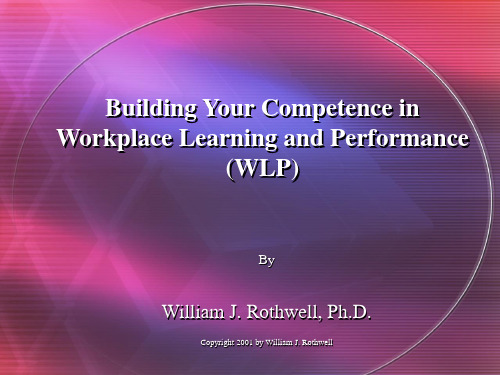
威廉·罗斯维尔2001版权所有
Part I:
Introduction
第一部分
简介
Purpose of the Session
Workplace Learning and Performance (WLP) is the latest generation of the field once called Human Resource Development (HRD) and, before that, Training and Development (T & D). How can you understand the field, the roles carried out by WLP practitioners, the competencies that are associated with successful performance in WLP now and in the future, and build your competencies as the WLP field changes in response to trends unfolding now? How might you apply this knowledge to year-end performance evaluation, compensation programs, and planning for the following year's HRD efforts? Use this two-day Workshop to build your competence as a WLP practitioner.
▪ Evaluate the financial and no financial results of an intervention
lifelonglearning英语作文
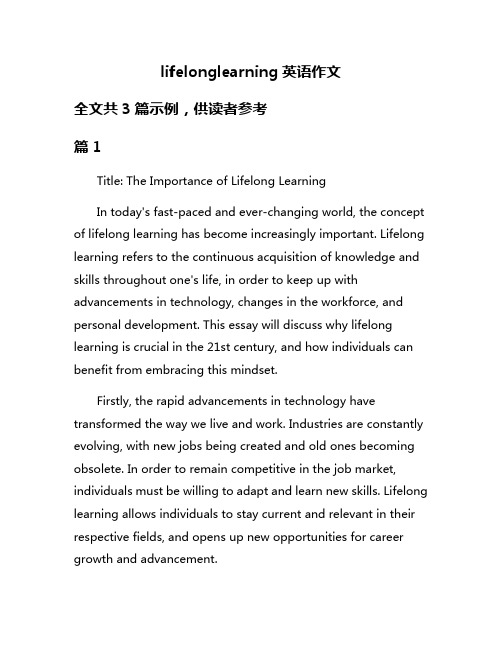
lifelonglearning英语作文全文共3篇示例,供读者参考篇1Title: The Importance of Lifelong LearningIn today's fast-paced and ever-changing world, the concept of lifelong learning has become increasingly important. Lifelong learning refers to the continuous acquisition of knowledge and skills throughout one's life, in order to keep up with advancements in technology, changes in the workforce, and personal development. This essay will discuss why lifelong learning is crucial in the 21st century, and how individuals can benefit from embracing this mindset.Firstly, the rapid advancements in technology have transformed the way we live and work. Industries are constantly evolving, with new jobs being created and old ones becoming obsolete. In order to remain competitive in the job market, individuals must be willing to adapt and learn new skills. Lifelong learning allows individuals to stay current and relevant in their respective fields, and opens up new opportunities for career growth and advancement.Secondly, lifelong learning is essential for personal development and growth. Learning new things not only expands one's knowledge and skills, but also fosters creativity, critical thinking, and problem-solving abilities. It can lead to increased self-confidence and a sense of accomplishment, as individuals challenge themselves to reach new goals and aspirations. Lifelong learning also promotes mental stimulation and cognitive health, helping individuals stay sharp and engaged as they age.Moreover, lifelong learning can enrich one's life in numerous ways. It provides opportunities for personal fulfillment andself-discovery, as individuals explore new interests and passions. It allows for cultural enrichment and global awareness, as individuals learn about different perspectives and ways of life. Lifelong learning can also foster social connections and community engagement, as individuals interact with others who share their interests and values.In order to embrace lifelong learning, individuals need to adopt a growth mindset and a willingness to learn. This involves staying curious and open-minded, seeking out new challenges and experiences, and taking advantage of learning opportunities in various forms. This could include enrolling in formal educationprograms, attending workshops and seminars, reading books and articles, watching online tutorials, and engaging in hands-on projects.In conclusion, lifelong learning is an essential mindset for success and fulfillment in the 21st century. It is through continuous learning and growth that individuals can adapt to the changing world around them, develop their potential to the fullest, and lead a more enriching and meaningful life. By embracing lifelong learning, individuals can stay relevant, expand their horizons, and unlock their full potential. So let us commit to being lifelong learners, and continue to grow and thrive in our personal and professional lives.篇2Title: The Importance of Lifelong LearningIntroductionLifelong learning is the continuous pursuit of knowledge and skills throughout one's life. It goes beyond traditional education and training, allowing individuals to adapt to the rapidly changing world and develop personally and professionally. In this essay, we will discuss the importance of lifelong learning and its benefits.Why is lifelong learning important?1. Personal developmentLifelong learning helps individuals grow and improve themselves. By acquiring new knowledge and skills, they can become more competent, confident, and successful in their careers and personal lives. It also promotes intellectual curiosity, critical thinking, and creativity, leading to a more fulfilling and enriching life.2. Professional developmentIn today's fast-paced and competitive job market, continuous learning is essential to stay relevant and marketable. Employers value employees who are adaptable, innovative, and up-to-date with the latest trends and technologies. Lifelong learning provides opportunities for career advancement, job satisfaction, and increased earning potential.3. AdaptabilityThe world is constantly changing, and individuals need to adapt to new challenges and opportunities. Lifelong learning enables them to stay flexible and resilient in the face of uncertainty. It helps them embrace change, overcome obstacles, and thrive in an ever-evolving environment.4. Social connectionLifelong learning fosters social interaction and community engagement. It brings people together to share knowledge, experiences, and perspectives. It creates a sense of belonging, support, and collaboration, enhancing relationships and building a strong network of like-minded individuals.Benefits of lifelong learning1. Enhanced personal growth and well-beingLifelong learning promotes self-awareness, self-confidence, and self-improvement. It boosts motivation, happiness, and overall well-being. It empowers individuals to set goals, pursue passions, and achieve their full potential.2. Improved job performance and career prospectsLifelong learning enhances job skills, performance, and productivity. It increases employability, job satisfaction, and job security. It opens doors to new opportunities, promotions, and career transitions.3. Continued relevance and competitivenessLifelong learning keeps individuals current, competitive, and agile in a rapidly changing world. It equips them with theknowledge, skills, and mindset to adapt, innovate, and succeed in any industry or profession.4. Lifelong learning in actionThere are many ways to engage in lifelong learning, such as taking courses, attending workshops, joining clubs, reading books, watching videos, and networking with others. It is never too late to start learning and growing, no matter your age, background, or circumstances.ConclusionLifelong learning is a lifelong journey of discovery, growth, and transformation. It is the key to personal and professional success, happiness, and fulfillment. By embracing learning as a way of life, we can become the best version of ourselves and make a positive impact on the world. Let us commit to lifelong learning and seize the endless possibilities that await us.篇3Lifelong learning is the ongoing process of acquiring knowledge and skills throughout one's life. It is a dynamic and transformative journey that can lead to personal growth, professional development, and a deeper understanding of the world around us.One of the key benefits of lifelong learning is the opportunity to adapt to the rapid changes in our society and economy. As technology and innovation continue to advance at a rapid pace, the skills needed to succeed in the workforce are constantly evolving. Lifelong learning enables individuals to stay current and relevant in their field, ensuring they remain competitive and marketable in the job market.Furthermore, lifelong learning can enhance personal growth and well-being. By continuously seeking out new experiences and knowledge, individuals can expand their horizons, challenge their assumptions, and develop a deeper sense of self-awareness. This can lead to a greater sense of fulfillment and satisfaction in life, as well as improved mental and emotional well-being.Lifelong learning also fosters a culture of curiosity, creativity, and innovation. By actively engaging with new ideas and perspectives, individuals can cultivate their critical thinking skills, problem-solving abilities, and adaptability. This can lead to the development of innovative solutions to complex challenges, as well as a greater capacity to think outside the box and push the boundaries of what is possible.Moreover, lifelong learning can promote social connection and community engagement. By participating in educationalprograms, workshops, and seminars, individuals have the opportunity to interact with others who share their interests and passions. This can lead to the formation of new friendships, networks, and support systems, as well as a greater sense of belonging and connectedness to the world around them.In conclusion, lifelong learning is a powerful tool for personal and professional growth, as well as social and cultural enrichment. By embracing a mindset of curiosity, openness, and continuous improvement, individuals can unlock their full potential and lead a more fulfilling and meaningful life. So let's commit to lifelong learning and embark on this transformative journey together.。
学业和锻炼英语作文
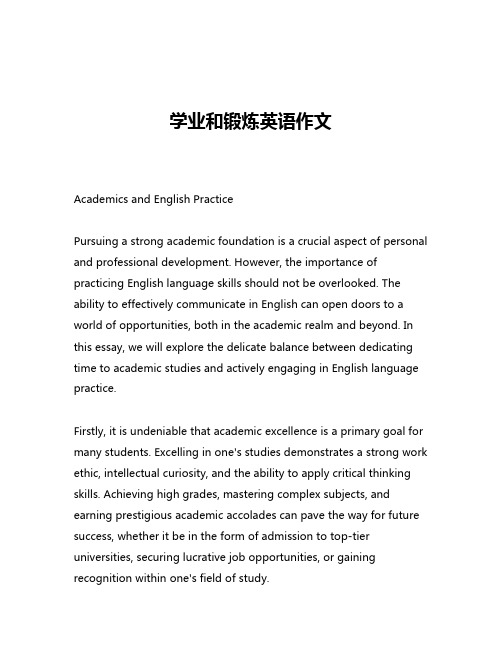
学业和锻炼英语作文Academics and English PracticePursuing a strong academic foundation is a crucial aspect of personal and professional development. However, the importance of practicing English language skills should not be overlooked. The ability to effectively communicate in English can open doors to a world of opportunities, both in the academic realm and beyond. In this essay, we will explore the delicate balance between dedicating time to academic studies and actively engaging in English language practice.Firstly, it is undeniable that academic excellence is a primary goal for many students. Excelling in one's studies demonstrates a strong work ethic, intellectual curiosity, and the ability to apply critical thinking skills. Achieving high grades, mastering complex subjects, and earning prestigious academic accolades can pave the way for future success, whether it be in the form of admission to top-tier universities, securing lucrative job opportunities, or gaining recognition within one's field of study.However, the pursuit of academic excellence should not come at the expense of neglecting the development of English language proficiency. In today's globalized world, the ability to communicate effectively in English has become increasingly valuable. Whether it is delivering presentations, participating in discussions, or writing academic papers, strong English skills are essential for academic success and beyond.Practicing English can take many forms, from reading extensively in the language to engaging in conversations with native speakers. Immersing oneself in English-language media, such as books, films, and podcasts, can greatly enhance one's vocabulary, grammar, and overall fluency. Additionally, seeking out opportunities to interact with others in English, whether it be through language exchange programs, study groups, or social activities, can provide invaluable practice and build confidence in using the language.One effective strategy for balancing academics and English practice is to integrate the two. For instance, students can choose to read academic literature in English, rather than their native language, to simultaneously strengthen their subject knowledge and language skills. Similarly, when writing research papers or essays, students can make a conscious effort to improve their English writing style, sentence structure, and use of academic vocabulary.Moreover, the benefits of practicing English extend beyond the academic realm. Strong English language proficiency can open doors to a wide range of career opportunities, both locally and globally. Many multinational companies and organizations prioritize the hiring of individuals with excellent English communication skills, as they are able to effectively collaborate with colleagues, participate in international meetings, and serve a diverse client base.Furthermore, the process of learning and practicing English can have a positive impact on personal growth and cognitive development. The acquisition of a new language has been shown to enhance problem-solving skills, critical thinking abilities, and even memory function. Additionally, the sense of accomplishment and confidence that comes with mastering a foreign language can be immensely rewarding.In conclusion, the balance between academic pursuits and English language practice is a delicate one, but it is a balance that is well worth striking. By dedicating time and effort to both, students can maximize their chances of academic success while also positioning themselves for a future filled with diverse opportunities. Ultimately, the mastery of English, coupled with a strong academic foundation, can be a powerful combination that propels individuals towards their personal and professional aspirations.。
《3-6岁儿童学习与发展指南》英语
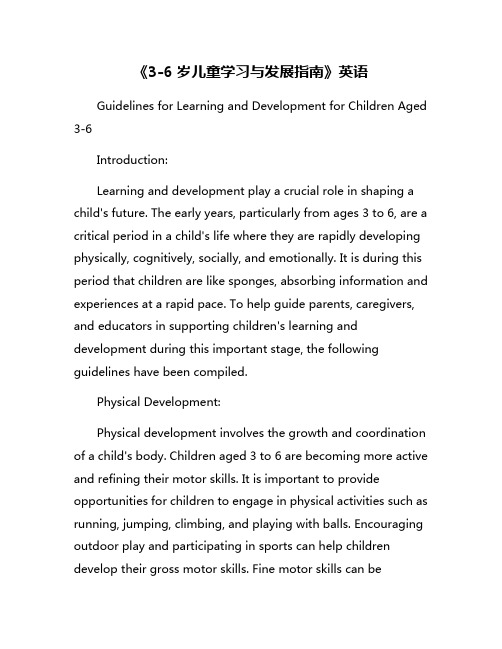
《3-6岁儿童学习与发展指南》英语Guidelines for Learning and Development for Children Aged 3-6Introduction:Learning and development play a crucial role in shaping a child's future. The early years, particularly from ages 3 to 6, are a critical period in a child's life where they are rapidly developing physically, cognitively, socially, and emotionally. It is during this period that children are like sponges, absorbing information and experiences at a rapid pace. To help guide parents, caregivers, and educators in supporting children's learning and development during this important stage, the following guidelines have been compiled.Physical Development:Physical development involves the growth and coordination of a child's body. Children aged 3 to 6 are becoming more active and refining their motor skills. It is important to provide opportunities for children to engage in physical activities such as running, jumping, climbing, and playing with balls. Encouraging outdoor play and participating in sports can help children develop their gross motor skills. Fine motor skills can bedeveloped through activities such as drawing, painting, cutting, and threading beads.Cognitive Development:Cognitive development refers to how children think, learn, and solve problems. In the 3-6 age range, children's cognitive abilities are rapidly expanding. They are acquiring new language skills, developing their memory, and learning to categorize and classify objects. Encouraging literacy and numeracy skills through books, puzzles, and educational games can help stimulate cognitive development. Activities that involve problem-solving and critical thinking, such as building blocks or shape sorting games, can also support cognitive growth.Social Development:Social development entails how children interact with others and form relationships. During the early years, children are learning to share, take turns, and communicate effectively with their peers. Encouraging children to engage in group activities, such as playdates or preschool, can help develop their social skills. Teaching children about empathy, kindness, and cooperation can also support their social development.Emotional Development:Emotional development involves how children understand and manage their feelings. From ages 3 to 6, children are learning to identify and express their emotions in a healthy way. It is important to create a nurturing and supportive environment for children to feel safe expressing their emotions. Encouraging children to talk about their feelings, teaching them coping strategies, and providing positive reinforcement can help support their emotional development.Conclusion:The early years of a child's life are a time of rapid growth and development. By following these guidelines for learning and development for children aged 3 to 6, parents, caregivers, and educators can help support children in reaching their full potential. By providing opportunities for physical, cognitive, social, and emotional growth, children can develop the skills and abilities they need to thrive in school and beyond. Remember, every child develops at their own pace, so it is important to be patient, supportive, and encouraging as they navigate this important stage of their development.。
学习行为评价作文用英文表述
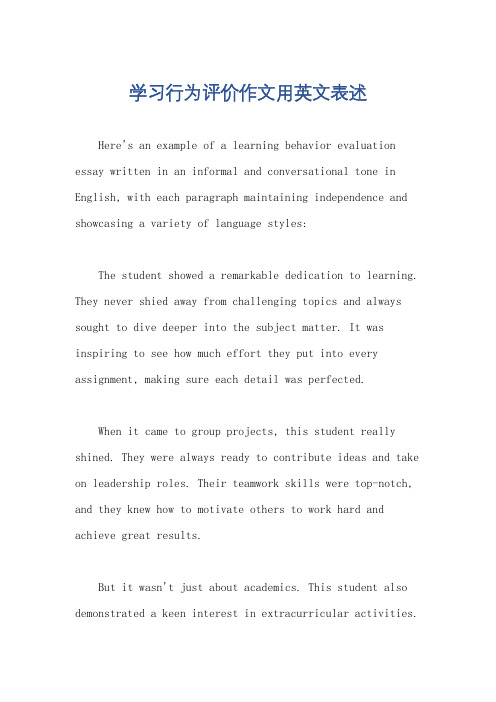
学习行为评价作文用英文表述Here's an example of a learning behavior evaluation essay written in an informal and conversational tone in English, with each paragraph maintaining independence and showcasing a variety of language styles:The student showed a remarkable dedication to learning. They never shied away from challenging topics and always sought to dive deeper into the subject matter. It was inspiring to see how much effort they put into every assignment, making sure each detail was perfected.When it came to group projects, this student really shined. They were always ready to contribute ideas and take on leadership roles. Their teamwork skills were top-notch, and they knew how to motivate others to work hard and achieve great results.But it wasn't just about academics. This student also demonstrated a keen interest in extracurricular activities.Whether it was participating in a debate club or volunteering at a local event, they always seemed to find a way to stay involved and make a difference.Their ability to adapt to new situations was truly impressive. When faced with a difficult challenge, they never panicked. Instead, they calmly analyzed the problem and came up with a creative solution. This resilience and adaptability will definitely come in handy in their future careers.Overall, this student is a joy to have in class. They bring a positive energy that inspires everyone around them. I'm confident that with their dedication, hard work, and passion for learning, they'll achieve great success in whatever path they choose.。
培养及发展潜力评语
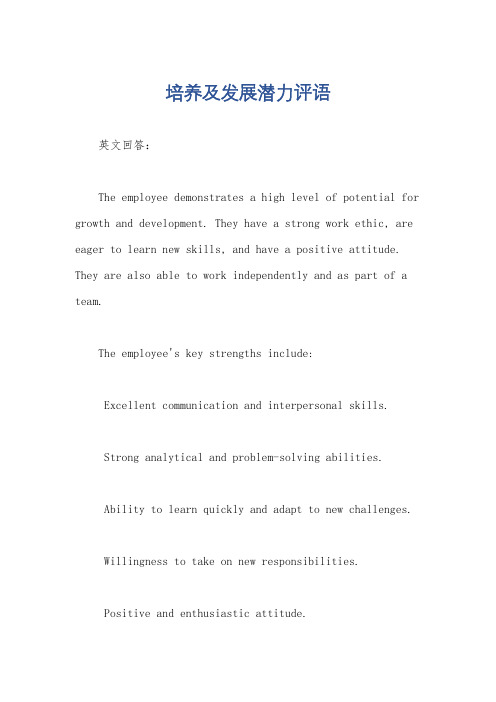
培养及发展潜力评语英文回答:The employee demonstrates a high level of potential for growth and development. They have a strong work ethic, are eager to learn new skills, and have a positive attitude. They are also able to work independently and as part of a team.The employee's key strengths include:Excellent communication and interpersonal skills.Strong analytical and problem-solving abilities.Ability to learn quickly and adapt to new challenges.Willingness to take on new responsibilities.Positive and enthusiastic attitude.Areas for development include:Developing a deeper understanding of the company's business and industry.Gaining more experience in leadership roles.Improving time management skills.Developing a stronger network of professional contacts.Overall, the employee is a valuable asset to the company and has the potential to be a future leader. With continued development and support, they are likely to achieve great success in their career.中文回答:该员工具有很高的成长和发展潜力。
心理发展与教育英文

心理发展与教育英文Psychological Development and EducationIntroduction:Psychological development is the process of maturation and growth in human beings that affects their cognitive, emotional, social, and behavioral aspects. The development of a child's mind and personality starts right from birth and can be influenced by various factors such as genetic make-up, environmental exposure, and social interactions.Education, on the other hand, is a deliberate process of imparting knowledge, skills, and values to an individual, with an ultimate goal of shaping them into responsible and productive members of society. The delivery of education and the approach taken by educators can have a significant impact on the psychological development of their students.The Relationship between Psychological Development and Education:The process of psychological development is influenced by environmental factors such asexperiences, interactions, and education. Education becomes a crucial factor in shaping the cognitive, emotional, and behavioral development of a child. Research-based evidence shows that the cognitive abilities and skills of children can be improved through education.This improvement manifests through improved problem-solving skills, analytical reasoning, and critical thinking. Education also plays a vitalrole in developing the emotional well-being of children. Children who get a comprehensive education that develops their social-emotional skills show better resilience and ability to cope with life's challenges.The role of Educators in Influence of Psychological Development:Educators play a crucial role in shaping the psychological development of a child. Educators play a significant role in creating safe learning environments and meeting the individual needs ofall students. They also provide critical guidanceand support to promote positive psychological development that influences academic achievement.In modern education systems, educators arewell-equipped to identify the strengths and the areas that need improvement in their students. They are trained to understand the various factors that affect children's psychological development and apply strategies that enhance psychological development.Conclusion:Psychological development and education are interrelated concepts that significantly impact the mental and emotional formation of a child. A comprehensive and quality education can influence the cognitive and emotional development of children, making them productive members of society. Therefore, it is critical for educators to understand the intricate relationship between psychological development and education, which helps them provide the skills, knowledge, and values necessary for children's growth and development.。
英语核心素养与教学评价

英语核心素养与教学评价The development of English language education has always been a crucial focus in the field of education. In recent years, the concept of "English core literacy" has gained increasing attention, as it emphasizes the cultivation of students' comprehensive language abilities beyond mere linguistic knowledge. This essay will explore the significance of English core literacy and its implications for teaching evaluation.English core literacy refers to the essential competencies and qualities that students should possess in the process of English language learning. It encompasses a wide range of skills, including but not limited to, language proficiency, critical thinking, cultural awareness, and effective communication. These core competencies are not only crucial for academic success but also essential for personal development and future career prospects.One of the key aspects of English core literacy is language proficiency. This encompasses the ability to comprehend and use English effectively in various contexts, including reading, writing,listening, and speaking. Proficient language skills not only enable students to excel in their academic studies but also facilitate their participation in global communication and collaboration. In the era of globalization, the ability to communicate fluently in English has become increasingly important for personal and professional advancement.Moreover, English core literacy emphasizes the development of critical thinking skills. This involves the ability to analyze information, evaluate arguments, and formulate well-reasoned opinions. In the age of information overload, the capacity to think critically and make informed decisions is essential. English language learning can provide a platform for students to hone these crucial cognitive skills, which can be applied across various academic and professional domains.Cultural awareness is another crucial component of English core literacy. As students engage with English language materials, they are exposed to diverse cultural perspectives and practices. Developing an understanding and appreciation of cultural differences not only enhances their language proficiency but also fosters cross-cultural communication and collaboration. In a world that is increasingly interconnected, the ability to navigate cultural nuances and adapt to diverse contexts is highly valued.Effective communication skills are also a vital aspect of English core literacy. This encompasses the ability to express ideas clearly, persuasively, and appropriately in various settings, such as presentations, discussions, and written assignments. Effective communication skills not only contribute to academic success but also play a crucial role in personal and professional development, as they enable individuals to collaborate, negotiate, and influence others.The significance of English core literacy has important implications for teaching evaluation. Traditional assessment methods that focus solely on language knowledge and test scores may not adequately capture the breadth and depth of students' English competencies. Instead, a more comprehensive and holistic approach to teaching evaluation is needed, one that emphasizes the assessment of students' core literacy skills.One approach to teaching evaluation that aligns with the principles of English core literacy is the use of performance-based assessments. These assessments involve the evaluation of students' ability to apply their knowledge and skills in real-world or authentic situations, such as project-based learning, oral presentations, or written assignments that require critical thinking and problem-solving. By focusing on the demonstration of competencies rather than just the recall of information, performance-based assessments can provide a moreaccurate and meaningful evaluation of students' English core literacy.Another important aspect of teaching evaluation in the context of English core literacy is the incorporation of formative assessments. Formative assessments are ongoing evaluations that provide feedback to both teachers and students, allowing for the identification of strengths, weaknesses, and areas for improvement. This approach enables teachers to adapt their instructional strategies and provide targeted support to students, ultimately enhancing the development of their English core literacy.Furthermore, the evaluation of English core literacy should also consider the development of students' self-assessment and reflection skills. By encouraging students to reflect on their own learning process, strengths, and areas for growth, teachers can foster a sense of ownership and agency in their language learning journey. This, in turn, can lead to more engaged and motivated students who are better equipped to take responsibility for their own development.In conclusion, the concept of English core literacy has become increasingly important in the field of English language education. It encompasses a range of essential competencies, including language proficiency, critical thinking, cultural awareness, and effective communication. The significance of English core literacy has important implications for teaching evaluation, as it calls for a morecomprehensive and holistic approach that goes beyond traditional assessment methods. By adopting performance-based assessments, formative evaluations, and fostering students' self-assessment skills, educators can better support the development of students' English core literacy and prepare them for success in an increasingly globalized world.。
- 1、下载文档前请自行甄别文档内容的完整性,平台不提供额外的编辑、内容补充、找答案等附加服务。
- 2、"仅部分预览"的文档,不可在线预览部分如存在完整性等问题,可反馈申请退款(可完整预览的文档不适用该条件!)。
- 3、如文档侵犯您的权益,请联系客服反馈,我们会尽快为您处理(人工客服工作时间:9:00-18:30)。
a more intuitive bias towards filtering and judging infority, where learners prefer either a subjective or objective
• Experiential – Learner chooses personal goals – Tutor acts as facilitator
Kolb’s Learning Cycle (1984)
Learning styles in an international context
• Kolb describes experiential learning form a partial western perspective • Learning styles will vary in terms of:
What is learning?
Learning… • Is complex and various • Is individual, and can be
collectively generated • Can be triggered by any
experience • Is both a process and an outcome • May be incremental, or can be
Learning , Development and Performance Management
Structure
• What is ‘learning’? • The value of L & D • The learning organisation • Corporate Universities • International Performance Management
Group and team level learning
• Collective learning – develop and share explicit and tacit knowledge in groups and teams (Asian Firms)
• However, some cultures accept hierarchical relationships making open dialogue difficult
• 21st century – work is increasingly team based and are cross-organisational
Discussion question:
Think of any instances (at work, in university etc…) in which you have worked or studied with those from other cultures. What issues in relation to learning have arisen?
approach to decision making, and finally – Behaviour modality - the extent to whether the learner prefers an
instructor or self-directed learning • We return to the work of Hofstede (Jackson 1995, cited in Lucas et al, 2006)
consequence of change • Has a moral dimension
(Honey, cited in Armstrong, 2001)
Instrumental vs Experiential Learning
• Instrumental: – focused on results – concern for subject matter – tutor = teacher (expert)
transformational • Can be conscious or unconscious
• Can be both planned and unplanned
• Outcomes may be desirable or undesirable
• Cannot take place without change • Can be both the cause and the
Why do we need to learn?
• Need for continuous learning to engender flexibility and responsiveness, constant adaptation and change
• ‘The rate at which individuals and organisations learn may become the only sustainable competitive advantage, especially in knowledgeintensive industries’ (Stata, 1989)
The Learning Organisation
“A learning company is an organisation that facilitates the learning of all its members and consciously transforms itself and its context.” (Pedler et al, 1991)
